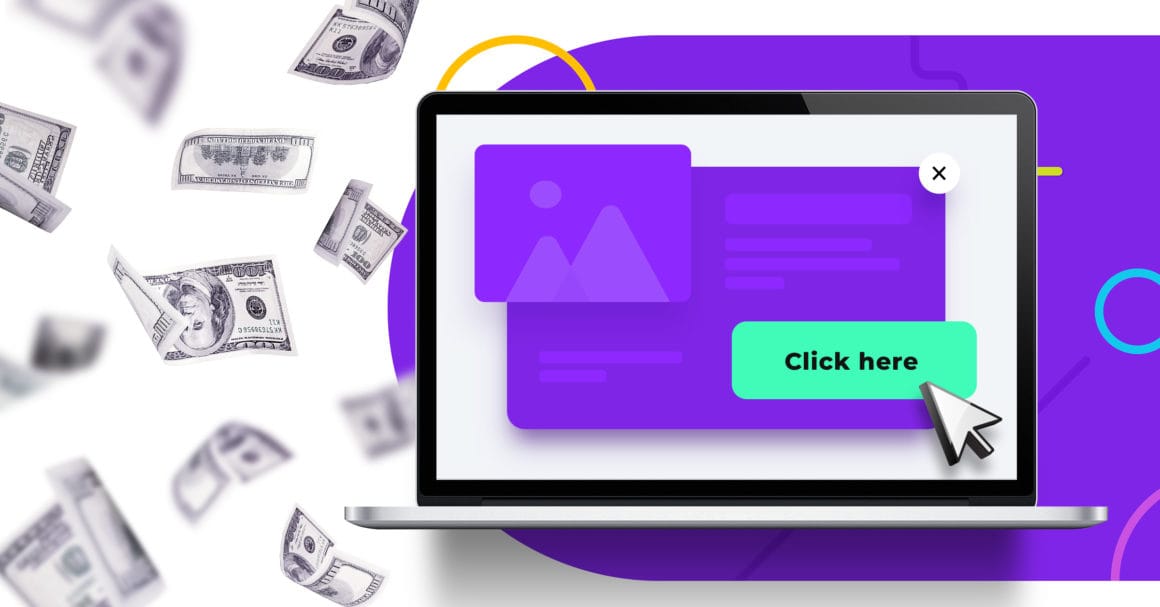PPC affiliate programs are a great way of monetizing traffic of your website – or a great incentive for building such a website. PPC affiliate programs can help bring your dreams of having a passive income to life.
While you can easily enhance your earnings with this passive stream of income, you have a lot of choices ahead of you.
So what’s best for you? Check out our ranking of the 15 best PPC affiliate programs to find the best fit for your website.
No banner with provided ID foundWhat is a Pay Per Click program?
PPC (Pay per click) affiliate programs can be extremely useful for affiliate marketers (and others) with websites that have a sustainable stream of interested, engaged traffic. In the PPC online advertising model, an advertiser pays a publisher (such as an affiliate marketer who owns a website or search engines) when an ad displayed on their site is clicked. PPC programs create networks where publishers can choose among multiple advertisers to find the best match of content for their site, or this process is automated through optimization algorithms. An alternative model is a bidding process where advertisers bid for the ad space on your website.
Google AdSense & its Alternatives
If you are familiar at all with PPC programs, you’ll probably first think of Google Ads. It’s the biggest, and one of the most reliable, easiest pay per click affiliate programs out there with great analytical tools – but not necessarily the best fit for you. In fact, given the wide variety of programs out there, it’s important to consider your needs, experience and strengths.
The Google PPC program can be very difficult to get in and stay in – they have very rigorous standards and metrics. Also, their pay rates are not as good as they used to be – and with a minimum payout of $100 it may take a while to actually see your profits.
Overall, the fact is that Google AdSense is built to serve a huge range of advertisers and publishers. That might be good for some advertisers or publishers with enormous capacity, but for those on the smaller side (like affiliate marketing site owners) or looking for more customized solutions, there are better Google AdSense alternatives out there. And in fact, you may not even need to entirely replace Google AdSense with an alternative, but rather find pay per click affiliate programs that are compatible alongside it.
Pay per Click Programs for Affiliate Marketers
Though affiliates may blog or build up websites because they love it – the true motivating factor behind it all is profits. And once you’re a successful affiliate marketer with a website that has lots of traffic and conversions, you can start making even more profits through a PPC affiliate program.
Granted, you have to be careful not to flood your website with ads – that is a pretty certain way to scare off or annoy viewers. However, allowing affiliate marketing publishers’ content that is directly related to your niche websites and not too intrusive can definitely boost your profits.
PPC Affiliate Referral Programs
If you already are or intend to be part of a click affiliate program, you might as well join their affiliate referral programs. By recommending pay per click programs, providing your affiliate referral link, and getting other publishers to sign on and make money, you can earn some totally passive income. Each pay per click affiliate program differs, but after a few hours of research, I’ve gathered the details on them all.

Ranking PPC Programs for Beginner – Medium – Advanced Affiliates
What makes a pay per click affiliate program easy-medium-hard?
The foremost things I looked at were application criteria (typically monthly minimum traffic amounts and traffic source stipulations) along with payout terms. Some of these ppc programs have very high, exclusive expectations (such as over 50k views per month) which are absolutely unattainable for beginners. On top of that, the minimum payout sum required by a PPC program is also an important consideration because if you’re just starting out, or even middle-of-the-road, you won’t be making huge sums… and waiting for $500, $100 to accumulate could take months before you ever see that money in your bank account.
Aside from these two main factors, I also accounted for other advantages and disadvantages of the PPC programs. Depending on the ease of the UI and ad formatting tools included, a program may be more or less suitable for beginners vs more advanced users. Many programs also have automated systems for placing ads on your site that auto-optimize placement to produce the highest engagement rates. Others enable you to do this manually if that is your preference – but this would probably be best for more experienced users.
And a final, important factor: how much you can make. This was measured in multiple ways: RPM, revenue share, and program key measures. Most likely, it goes without saying that the more advanced your site (more views, sessions, engagement) is, the more you will make. The pay per click affiliate programs in the advanced category of this ranking are generally where you make the most money. Therefore, though this factor is the main motivation for most everyone involved in a PPC program, it didn’t necessarily determine the rank of any of these programs according to the easy-hard scale.
PPC Affiliate Program components
- Ad formats: Most PPC programs support some kind of display ads, however, others specialize in other formats like video or native. Some have affiliate marketing focused ads that analyze the text within your posts/articles to deliver targeted affiliate ads.
- Minimum traffic requirements: Actually, many pay per click programs don’t have a minimum traffic requirement which makes them great for beginners. On the other end however, you’ve got ultra exclusive programs that not only have very high monthly traffic minimums, but also other stipulations related to content quality and traffic geo.
- Payment models: PPC programs tend to have similar Payment models but their payouts can differ greatly, usually depending on how exclusive the program is.
- RPM: “Revenue per mille” is the estimated earning per 1000 impressions. Given that many pay per click programs are measured based on impressions, RPM is a good way to measure profits. However, this isn’t applicable or available for every PPC program, so RPM is not included for all pay per click affiliate programs.
- Revenue share: The share you receive of gross proceeds paid by advertisers and networks as reported by the ad server.
- Key measures: These measures determine what actions will earn you money, such as CPC (cost per click), CPA (cost per action), CPM (cost per mille), CPL (cost per lead).
Payment structure:
The way you get paid by an affiliate program is an important consideration – especially if you are based outside of the US. I’ve detailed the most up-to-date terms for payment in each category, but these are subject to change. Be careful when you look at other blog posts too – I myself have run into numerous sources that have outdated information posted. But remember, these payment sums may also have additional fees (usually depending on where you are located, the currency you get paid in, and the payment method)
Minimum payment threshold: The minimum payment amount varies for each program from $5 to $500 or more; if you don’t make this threshold in a given pay cycle, you won’t be paid.
Payment methods: Some pay per click affiliate programs have a wide variety of payment methods while others only offer two or three. Make sure to verify whether you qualify for these.
Payment time: The “Net XX” payment cycle is the number of days you can expect to wait to receive your payment from a PPC program. The shortest is on a weekly basis while the longest can be up to 90 days (but this is an exception).
Referral programs + conditions: And one of the best ways to earn passive income? Off your referral’s revenue! Many PPC programs have their own pay per click affiliate programs (mainly those in the easy and medium categories). PPC affiliate referral programs are an ideal way to boost profits, though most affiliate programs are limited to one year about – but some are lifetime as well!
2 Important things to qualify for pay per click programs…
**An important thing to note: almost all pay per click affiliate programs, unless indicated in this list otherwise, operate only with clean, above-the-board websites. This means no sexuality, violence, weapons, illegal activities, malware, viruses, politics or religions on your website preferably. Advertisers online, like anywhere else, don’t want to be associated with controversial or dirty publishers.
**Another thing: since most programs listed here work with US-based advertisers, it’s best if the majority of your traffic comes from english-speaking countries, specifically the US and Canada. However, there are some multilingual PPC affiliate programs and they’re included in this list!
Pay Per Click Affiliate Programs for Beginners
Criteria:
• Low or no traffic threshold: Ideal for new sites or those still growing their audience
• Low payout minimums: So you can begin earning without long waiting periods
• Ease of integration and automated features: Minimizing technical hassle for newcomers
- Sovrn (formerly VigLink)
- Ads Supported: Contextual advertising integrated in blog/product reviews; offers additional tools (like //Signal for testing and an adblock unlocker).
- Traffic Requirements: None
- Payment Models: CPM, CPC (flat rate), or CPA
- Payout Details: Minimum thresholds are low ($10 via PayPal, $50 via ACH/check/wire transfers) with a Net 90 cycle
- Referral Incentives: Yes—earning 10–25% from referrals during the first six months
- Pros:
• Automated link conversion simplifies monetization.
• Low payout thresholds make it accessible for newcomers.
• Referral program can boost income early on. - Cons:
• Longer payout time (Net 90) may delay earnings visibility.
- SkimLinks
- Ads Supported: Contextual, in–text ads that convert regular product links into affiliate links
- Traffic Requirements: None
- Payment Models: Revenue split (roughly 75/25) with RPM varying by niche
- Payout Details: Typically around $65/€55/£50 minimum, with Net 90 payment terms
- Referral Incentives: Yes—35% of the commission in the first year from referred publishers
- Pros:
• Simple WordPress plugin integration and automatic tracking.
• No strict traffic requirements allow anyone to start. - Cons:
• Long payout cycle (Net 90) can slow cash flow.
• Does not support Amazon offers, limiting niche opportunities.
- PropellerAds
- Ads Supported: Popunders, native ads, banners, interstitials, and push notifications
- Traffic Requirements: None
- Payment Models: RPMs as high as $7 with various models available
- Payout Details: Starting as low as $5 (varies by payment method) and offers flexible payout cycles (weekly, Net 7, or monthly Net 30)
- Referral Incentives: Yes—5% of all lifetime revenue generated by referrals
- Pros:
• Wide range of ad formats provides flexibility in monetization.
• Multiple payout options (weekly/Net 7/Net 30) offer faster revenue access.
• Adblock bypass can boost earnings for smaller sites. - Cons:
• Some ad formats, such as popunders, may be perceived as aggressive and impact user experience.
- Adcash
- Ads Supported: Push notifications, popunders, interstitial, native ads, and banners
- Traffic Requirements: None
- Payment Models: CPA Target, CPM, and CPC
- Payout Details: Minimum thresholds start as low as $25, with varied payment methods (bank transfer, PayPal, and even Bitcoin) and a Net 30 cycle
- Referral Incentives: Yes—5% of your referrals’ lifetime earnings
- Pros:
• Offers extensive real–time reporting to help optimize placements.
• Multi-country support makes it versatile for various audiences. - Cons:
• Payment model details can be less transparent.
• Best suited for entertainment and gaming niches, which might limit broader appeal.
- InfoLinks
- Ads Supported: A mix that includes video, display, native, in–tag, in–text, and in–frame formats
- Traffic Requirements: None
- Payment Models: CPC with revenue sharing (typically around 65% to the publisher)
- Payout Details: Minimum payouts are modest ($50 for PayPal, eCheck, ACH; $100 for wire transfers) with a Net 45 cycle
- Referral Incentives: Yes—10% from each referral’s revenue for 12 months
- Pros:
• Real–time traffic analysis and automatic ad rotation can improve performance.
• Versatile ad formats enable integration into various content styles. - Cons:
• Moderate revenue shares may not maximize earnings for all niches.
• Payout thresholds, while modest, may still challenge very small sites.

Middle-of-the-Road Pay per Click Affiliate Programs
Criteria:
• Solid reputation and a wider range of ad formats: More mature networks
• Moderate entry requirements: Often suited for sites that already have a steady flow of quality traffic
• Better analytics and optimization tools: Helping intermediate publishers fine-tune their monetization
- Google AdSense
- Ads Supported: Text and display, in-feed, and in-article ads
- Traffic Requirements: None, although quality traffic (preferably US-based) improves earnings
- Payment Models: Up to $7 RPM with revenue sharing where the publisher receives about 68%
- Payout Details: $100 minimum payout with varied methods (checks, EFT, SEPA, etc.) and a Net 30 cycle
- Referral Incentives: None
- Pros:
• Extremely easy integration with many websites.
• Robust analytics through Google Analytics enhances performance tracking.
• Broad advertiser base provides steady demand. - Cons:
• Higher minimum payout ($100) can delay earnings for smaller sites.
• Strict policies and risk of banning (e.g., click fraud) may deter experimentation.
• Limited customization options for ad placement.
- Media.net
- Ads Supported: Contextual, display, mobile, interstitial, and in-content ads
- Traffic Requirements: Ideally, a significant part of your audience comes from the US, UK, or Canada
- Payment Models: A mix of CPM, CPC, CPA, and CPL with RPMs up to $10
- Payout Details: Minimum thresholds of around $100 with payment options like Payoneer or wire transfer and a Net 30 cycle
- Referral Incentives: Yes (detailed rates aren’t widely published)
- Pros:
• Premium ad inventory through the Yahoo-Bing network.
• Automated optimization that can improve earnings.
• Great alternative if you’re looking beyond AdSense. - Cons:
• Best performance when traffic is primarily from developed markets (US, UK, Canada).
• May not support some international languages or audiences as robustly.
- Bidvertiser
- Ads Supported: A range including native, push notifications, popunders, and even XML-based ads
- Traffic Requirements: Your site should be at least 3 months old
- Payment Models: CPC, CPM, and CPA
- Payout Details: Low thresholds ($10 via PayPal, $100 for checks) with a Net 30 cycle
- Referral Incentives: Yes—bonuses based on referred publishers’ earnings
- Pros:
• Offers the ability to choose your advertisers for more tailored content.
• Quick, automated approval process helps get you started fast.
• Flexible models (CPC, CPM, CPA) accommodate various strategies. - Cons:
• Revenue potential can be inconsistent without careful ad selection.
• Requires your site to be established (minimum 3-month-old), which may not suit every beginner.
- RevenueHits
- Ads Supported: Display banners, popunders, in-page push, and several other creative formats
- Traffic Requirements: None (but engagement is key, since it’s CPA–only)
- Payment Models: Strictly CPA with RPMs up to $10
- Payout Details: Low threshold ($20 via PayPal or Payoneer; higher for wire transfers) with a Net 30 cycle
- Referral Incentives: Yes—earning 5–10% from your referrals’ CPA revenue for the first year
- Pros:
• CPA model can deliver higher payouts with engaged traffic.
• Offers a 100% fill rate with algorithm-optimized ad placement.
• Effective for websites with an audience inclined to take action. - Cons:
• Relying solely on CPA may challenge publishers with less conversion-focused traffic.
• Must maintain highly engaged users to see significant results.
- Adsterra
- Ads Supported: Popunders, social bars, web push, native ads, pre-roll videos, and banners
- Traffic Requirements: None, though the network is somewhat exclusive
- Payment Models: CPM, CPC, CPA, CPL, and CPi
- Payout Details: Minimum thresholds can be as low as $5 for certain payment methods with a very fast Net 15 payout option
- Referral Incentives: Yes—5% of your referrals’ lifetime revenue
- Pros:
• Offers a diverse suite of ad formats to match your site’s style.
• Extremely fast payout options (as quick as Net 15).
• Low minimum thresholds make it accessible for emerging sites. - Cons:
• The network’s exclusivity might lead to stricter acceptance criteria.
• Varied ad quality can affect the overall user experience.
- Outbrain
- Ads Supported: Sponsored/editorial content, branded carousel cards, and video content
- Traffic Requirements: No formal minimum, but the network favors high–quality, engaging content
- Payment Models: RPMs can go up to $10 (exact details depend on contracts)
- Payout Details: Around $50 minimum, with Net 60 or 90 cycles based on your arrangement
- Referral Incentives: None
- Pros:
• High-quality native advertising that integrates seamlessly into content.
• Supports multiple languages, broadening audience reach.
• Recognized for high engagement among premium publishers. - Cons:
• Difficult to get accepted if your content isn’t deemed premium enough.
• Payout cycles and minimums may be less flexible for smaller publishers.
Pay Per Click Affiliate Programs for Advanced Publishers
So you’ve reached the top. Your website is thriving and you want to make the most of it. It’s always a good idea to keep a look out for better and more profitable PPC programs because the more you grow, the more you can offer. The next 5 pay per click affiliate programs are not easy to get into and qualify for, but once you are in, you’ll be making significantly more money.

Pay Per Click Affiliate Programs for Advanced Publishers
Criteria:
• High traffic and high–quality content requirements: Only networks that support premium inventory
• Advanced tracking, machine learning, and optimization tools: To maximize high volume revenue
• Stricter entry criteria: Generally reserved for sites with established performance and robust analytics
- Ezoic
- Ads Supported: Display, native, link units, anchor ads, sticky sidebar, in–image, vignette ads, interstitial video
- Traffic Requirements: Typically 10,000+ visits per month
- Payment Models: CPM-based earnings with RPMs reaching up to $15 (often measured as EPMV)
- Payout Details: Minimum thresholds starting at around $20 with multiple payment options (check, PayPal, direct deposit, etc.) and a Net 45 cycle
- Referral Incentives: Yes—earning around 3% of the referred publisher’s Ezoic earnings
- Pros:
• Uses machine learning for ad optimization that can significantly boost revenue.
• Comprehensive analytics and testing tools let you fine-tune ad placements.
• Referral program offers added passive income. - Cons:
• Requires consistent traffic (10,000+ visits/month) to benefit fully.
• Advanced features may come with a learning curve.
- Mediavine
- Ads Supported: Banner and native ad formats specifically designed for lifestyle and content–rich sites
- Traffic Requirements: Usually a minimum of 50,000 sessions per month (often around 60,000 pageviews) plus quality, original content
- Payment Models: Revenue sharing (starting at 75% to publishers, increasing with higher impression volumes)
- Payout Details: Minimum thresholds around $25/$200 (depending on the region/payment method) with a Net 65 cycle
- Referral Incentives: None
- Pros:
• Highly competitive revenue share structure that scales with volume.
• Works with premium advertisers, resulting in high-quality ad placements.
• Transparent reporting helps publishers optimize content effectively. - Cons:
• Strict entry requirements limit access to established sites.
• Predominantly suited to lifestyle or content-rich niches, which may not suit everyone.
- Raptive
- Ads Supported: A wide array including header, sidebar, sticky, in–content, in–image, sticky footer, video, interscroller, interstitial, and native outstream formats
- Traffic Requirements: A minimum of 100,000 pageviews a month with the majority coming from the United States and proper tracking via Google Analytics
- Payment Models: Revenue sharing (75% to publishers with RPMs up to $30)
- Payout Details: Minimum thresholds roughly around $25/$100, with a Net 45 cycle
- Referral Incentives: None
- Pros:
• Offers premium, high-earning ad placements optimized for quality content.
• Additional traffic and SEO support can help boost overall site performance.
• High RPM potential rewards established publishers. - Cons:
• Very high traffic requirements (100k+ pageviews/month) exclude smaller sites.
• Primarily focused on US traffic, limiting effectiveness for international publishers.
- AdBlade
- Ads Supported: Banner ads and a unique “Newsbullets” style that resembles native news stories
- Traffic Requirements: Generally a minimum of 500,000 pageviews per month
- Payment Models: CPC, CPM, and real–time bidding arrangements
- Payout Details: Typically starts at around $100 (domestic) to $250 (international wire transfer) and follows a Net 30 cycle
- Referral Incentives: None
- Pros:
• Innovative ad formats can lead to 3x better performance in the right context.
• Comprehensive real–time reporting aids in ad optimization.
• Flexible bidding system can maximize revenue when high traffic is achieved. - Cons:
• Requires very high traffic levels (500k pageviews/month), putting it out of reach for many.
• Not well-suited for publishers outside textual or news-based content.
- Revcontent
- Ads Supported: Native widgets that focus on content recommendation
- Traffic Requirements: A minimum of 50,000 visits per month
- Payment Models: Typically based on CPC with revenue enhancements up to an additional 20% CPM
- Payout Details: Minimum thresholds around $100–$1000 based on the payment method (with options like direct deposit, PayPal, and wire transfers) and a Net 30 cycle
- Referral Incentives: Historically offered some referral incentives, but these are currently minimal or have changed
- Pros:
• Known for high engagement rates and content-driven ad placements.
• Granular control over ad content allows better alignment with site topics.
• Native format can blend seamlessly with editorial content. - Cons:
• Requires very high-quality, engaged traffic to perform optimally.
• Changing referral incentives may reduce the benefit for network expansion.
So which one?
So hopefully, you are now aware of where your affiliate marketing or other site falls on the pay per click affiliate programs scale. It’s important to choose one where you can both make money as a publisher but also continue to grow your site.
And if you already are working with a PPC program, make sure to check out your options – like I said, the more traffic and quality content you offer, the more valuable you become. Certain PPC programs may simply not be able to offer you as much as others so when it’s time to graduate on up, you should.
And, like any and all advertising endeavors, it’s essential that you track everything to ensure profitability. That’s where Voluum Tracker comes in to support you, your website, and your campaigns.



